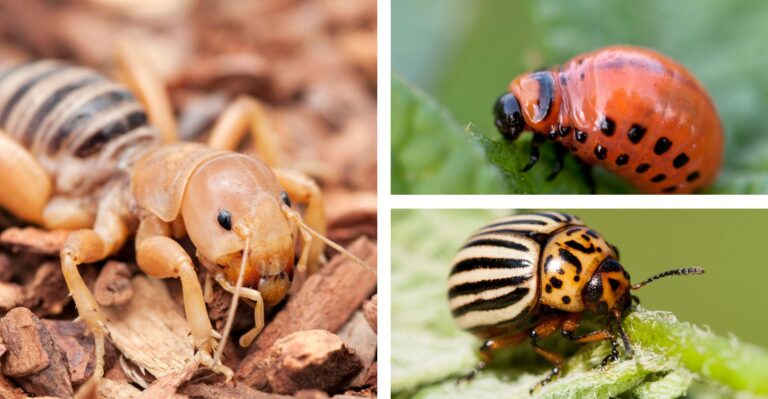Amazon has put together some great Home Gift Deals – save money and get your shopping done at the comfort of your home! Click here to see deals on Amazon
The groundhog is known by several names across North America, such as the woodchuck, whistle pig, and land beaver. As we all know, groundhogs are attracted to the taste of freshly grown fruits and vegetables.
They will eat the lawn to the ground and leave nothing but barren dirt behind. It’s known for burrowing holes and tunnels into the ground, becoming a very destructive pest for lawns and gardens.
This guide will walk you through the best ways, including the use of groundhog repellent, to stop them from destroying your garden. By educating yourself about their habits and habitat, you can make the most informed decisions about the steps you can take to repel them.
How to identify groundhog damage?
Groundhogs are excellent diggers, and often they form an extensive tunnel system (usually 10–12 inches long) that weakens the ground. This may cause extensive structural damage to property or result in injuries.
Besides, they’re voracious eaters that can damage the whole garden in a short bit of time. Before you start taking countermeasures, it’s vital that you first identify that the groundhogs had caused the damage.
Here are some ways you can quickly identify groundhog damage.
- You hear distinctive squeaking bark and observe them running around in the yard. The groundhog is also named “whistle pig” as they produce high pitch whistling noise.
- You find multiple tunnels or openings in the ground across the garden. Groundhog is notorious for making several different tunnels to keep their escape route ready.
- You will observe damage to vegetables and fruits with about 1/2-inch-wide teeth marks on them.
- There will be chewed-up branches and plants that may resemble damage caused by beavers.
- A large number of dirt mounds in front of a ground hole as groundhogs actively dig underground and moves dirt to the hole opening.
How to get rid of groundhogs?
Groundhogs are one of the most common pests across the nation. These notorious rodents are famous for burrowing in the ground and eating anything green within their sight. Unfortunately, groundhogs are known for harassing people by ruining their yards and gardens.
If you want to get rid of these pests, follow these tips.
1. Use Homemade Groundhog Repellent
Groundhog repellents are the easiest way to control the pest population in the yard. There are two most common types of effective repellent that you can have:
- Chemical-based groundhog repellent
- Homemade repellent
Chemical Repellent: A chemical-based repellents are very effective and easy to apply around fencing and the perimeters of your garden. You may often find these repellents sold in home stores, garden centers, or you can order them online.
You have to be careful when using chemical repellent. It can be harmful to pets and humans, depending on the ingredient inside.
Human Urine: This may sound absurd, but several gardening experts vouch for using male human urine spray as a kind of “groundhog repellent.” The idea is that the smell of human urine will repel the animals.
In the past, people have used urine as a natural fertilizer and to fight weeds, so it’s not surprising that it’s an idea that comes up repeatedly.
Coyote Urine: Coyote urine made repellent is very effective in keeping groundhogs away. It’s an organic way to reinforce the “keep out” message for rodents.
You can buy coyote urine spray, or you can make your own by buying dried coyote urine granules online as an active ingredient.
Spraying your garden with coyote urine won’t harm other animals. It won’t harm you but will repel groundhogs and other garden pests.
For best perimeter protection, you have to respray it after rain or watering your lawn. The good thing is that people will hardly notice the urine smell. But groundhog’s sensitive nose and keen sense of smell find it threatening to their survival without needing toxic chemicals.
Best Groundhog Repellent in 2024
- I Must Garden Groundhog Repellent (Best performing)
- Rabbit & Groundhog Repellent (Runner up 1)
- Tomcat Mole & Gopher Repellent Granules (Multi-purpose repellent)
- Natural Armor Animal & Rodent Repellent (Best for small garden)
- Critter Out Rodent Repellent (Best value repellent)
2. Apply Groundhog Repelling Scents
You can keep your yard safe from unwanted critters by applying a repelling scent every spring. You can use items available in your home to make these repelling sprays.
For example, you can make garlic pest repellent by crushing garlic cloves and squeezing the juice into a bottle. Fill it with a dishwater soap and spray it near the groundhog burrows.
You can make the same solutions using cayenne pepper or red pepper. Keep the solution potent by not diluting it too much. Usually, mix 2–3 teaspoons of pepper with a quarter amount of water and fill it in a pepper spray bottle.
It’s safe to use a homemade organic repellent than using harmful chemicals. This homemade repellent is non-toxic and doesn’t harm soils, making it suitable to use around vegetable plants and fruits.
3. Spread Human Hair Clippings
Groundhogs are naturally scared of humans and don’t like human proximity. You can spread short human hair clippings to areas where groundhogs visit to deter them from coming back.
You can wrap hair in a mesh bag to prevent it from blowing away from your yard. If you need some hair, you can get hair clippings from local barbershops.
4. Sprinkle Epsom Salts
You may be surprised to learn that Epsom salt has many uses that have nothing to do with soaking tired feet. You can sprinkle it near the groundhog burrows that deter them.
Epsom salt is a natural mineral salt without any harmful effects. You can find it in the pharmacy section of your local store or a home store. Be aware that some Epsom salt is mixed with ammonia which is toxic when ingested.

5. Apply Castor Oil Around Burrow Holes
Castor oil is a very effective natural pesticide. It’s natural because it’s derived from a plant and not manufactured in a lab. It works by smothering groundhogs.
You can mix a tablespoon of castor oil in a gallon of water and a small amount of liquid dish to prepare natural repellents. Spray these woodchuck repellents around the groundhog holes and the places they like to visit.
You shouldn’t spray it near the edible plants as you shouldn’t consume castor oil. You may have to reapply it after rain or watering your garden.
6. Install Fence Around The Garden
If your yard is suffering from the wrath of a groundhog, you can use fences as a simple and effective way to stop them from damaging your yard.
To keep fencing remain effective, ensure it goes up to 3 to 4 feet in the ground and install an “L-shaped” fence to prevent groundhog digging around.
Some people recommend using chicken wire, but that becomes ineffective if the groundhog finds any small opening to dig underneath it.
7. Catch And Relocate With A Live Trap
Catching groundhogs using a live trap is the most effective and humane way to deal with these pesky rodents. You can set a live trap baited with apples, corn, sunflower seeds, or peanut butter.
You should set up a baited live trap at the groundhog burrow entrance. To make it not suspicious to groundhogs, you can conceal it with grass and leaves. But before you use this strategy, check your local by-law as you may need to get a permit.
8. Turn On The Motion-Activated Sprinkler
The above live trapping method works effectively to catch and relocate the pesky groundhog that keeps digging up your garden. But it’s easier and less troublesome to scare it away with a sprinkler or hose.
You just need to decide what method you should use. The best approach is to water the area around your garden and drench the groundhog. A motion-activated sprinkler works best to spook groundhogs and scare them enough to deter returning.
9. Maintain Lawn By Mowing Grass And Trimming Shrubs
Here is the truth, the key to keeping groundhogs away from your yard is to deny them what they want most: cover and food.
By keeping the grass short, clearing piles of debris, and ensuring there are no shrubs within the groundhog’s reach, you can effectively keep them out.
A neatly maintained lawn by regularly cutting shrubs short or mowing lawns will eliminate groundhog covers. This will scare them to stay in the open and encourage them to find better and safe spots.
10. Feed Juicy Fruit Chewing Gum
You can eliminate them by feeding juicy fruit chewing gum. Groundhogs find the smell and high sugar content very appealing. Place these chewing gums inside the groundhog holes and wait for a few days.
The chewing gum clogs their digestive tracts, making them unable to eat and digest food. Due to lack of food, groundhogs eventually die.
11. Fill Groundhog Burrow With Tunnel Fill
Tunnel fill is a new product in a market that absorbs water and swells several times its size. It’s a great way to trap groundhogs in the burrow or prevent them from making a home in any existing hole.
Filling holes with tunnel fill also prevents the weakened and hollow ground from sinking, reducing injury risk.

12. Scare Groundhogs
You can scare groundhogs through physical means such as installing pinwheels or shiny objects. Placing dummy predator statues such as owl or fox scares groundhogs, and they don’t dare to get into your yards.
13. Smoke Tunnel With Firebombs
You can buy a commercial smoke firebomb to kill groundhogs inside a burrow. These firecracker-sized sticks are easy to use. You simply insert the smoke firebomb in the burrow and light it up.
Cover the hole with provided cover and spread dirt around it to prevent smoke from escaping. You have to ensure that groundhogs don’t have any other escape route, and they’re inside the burrow when you lit the smoke bomb.
It’s preferred that you first mark the burrows where groundhogs live and use smoke at night when they’re likely resting inside.
14. More Frequent Garden Watering
One way to keep these pests away from your yard is to water your lawn more often than you would typically do. Groundhogs don’t like wet feet, so they will avoid the area where they feel the dampness.
The wet ground prevents the groundhog from making a tunnel system as it increases the risk of ground collapse. This is a very straightforward and effective way to discourage groundhogs from returning to your yard.
15. Let Loose Pets In The Garden
Keep your yard free of groundhogs by using pets to repel them. If you have a dog or cat in your home, you can allow them to play in the yard.
Groundhogs consider them as predators and keep away where these animals are present. It’s a no-cost but effective solution.
16. Spread Soiled Kitty Litter
While some people may think it’s gross, grimy, and possibly even dangerous to use soiled cat litter to repel a pesky groundhog, others swear by it.
If you’re a gardener who has trouble with groundhogs digging up your plants, you can try putting some of the soiled cat litter out in the garden. Just make sure you use the unscented litter, and the scent of the litter will deter the groundhogs or other animals from digging in your garden.

17. Install Barbed Wires As A Deterrent
Installing barbed wire is an effective way to deter groundhogs. You can use any barbed wire to install as a groundhog barrier, but a regular barbed wire is the least effective.
It doesn’t have enough sharp points to make it uncomfortable for the groundhogs to walk on, and they don’t have to worry about getting hurt anymore.
Using a sharp barbed wire makes rodents uncomfortable, and they tend to find better and safer places to make a home.
18. Ultrasonic Groundhog Repellent
There are several ultrasonic repellents available that you can buy. Their effectiveness is hit or miss, but it’s a safety device that doesn’t involve chemicals or lethal traps.
The ultrasonic repeller frightens and controls groundhogs and other pests such as chipmunks, rabbits, and squirrels. It’s motion-activated and emits a high-frequency ultrasonic sound that’s above the audible range of humans but irritates the ears of pests.
19. Hire A Professional
Having a groundhog in your garden or other critters in your yard is a hassle. But you can take care of it yourself. If you decide to go with a professional exterminator, make sure you do your homework first.
Read online reviews, and ask family and friends for experience with pest control companies in your area. Pest control professionals typically charge by the hour, ranging from a minimum of about $50 to $100 an hour or more.
You should consider engaging them if the infestation is out of hand and you need professional help to eliminate pests.

Don’t forget to share this post







